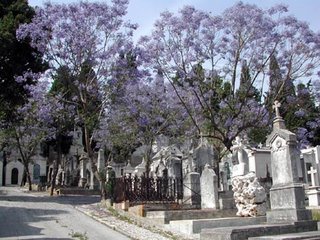Special Dossier: DEATH - The Cemetery

Cemeteries were not only important cultural institutions, but also tourist attractions.
In the European tradition, the place of burial was either inside the church or within its vicinity. The practice had its origin in the custom, which began very early in the Christian era, of seeking burial sites near the tombs of martyrs in order to obtain their protection during the long wait for the Day of Judgement.
The church, which took over this function during the Middle Ages, retained it through the 18th century.
The burial site, and the nature of its commemoration was a matter of social position. The structure of medieval society was preserved in death as it had been in life. Priests, monks, bishops, and abbots were buried within the church, as were saints and members of royal families.
Others were given this privilege only if they could afford to pay for it. The most revered and important people were buried in tombs, while others were interred in the walls or under the floor.
The most desired place of burial was near the altar. The hierarchical arrangement was also repeated outside of the church: the most coveted positions were the ones nearest the church.
In the adjacent cemetery, the graves were common ones. The site of burial was neither commemorated nor permanent.
The bones of the majority of people were disinterred and stored elsewhere, and the pits reused for new interments. Cemeteries, moreover, were not only places of burial, but were used as markets, forums, and malls.
The cemetery was thus the forerunner of the public square. The church and its cemetery defined the centre of public life, both religious and secular.
A cemetery is viewed as a perfect sanctuary from the city. It not only offered a combination of romantic conceptions of nature with those of death, but also continued and extended the traditional associations of the cemetery with the church. Now, however, the cemetery, as part of nature, was itself a church.
To these consecrated grounds we would resort as we attend service in the house of God, to indulge in serious meditation, and to ponder on those themes, which are neglected by the multitude, during the hurry of business or in the idle whirl of pleasure.
The desired effect was one of solemn rusticity, a domain of nature enhanced by the subtle intercession of man. It was accomplished by creating winding paths amid a diversity of outlooks--narrow and expansive, light and dark, wooded and grassy. Frequent highlights included small lakes and streams, isolated grottoes, and picturesque structures. They also included the tombs of family or friends, or monuments to their memory.
The English garden had a tremendous impact on garden design in the rest of Europe that persisted well into the nineteenth century.


<< Home